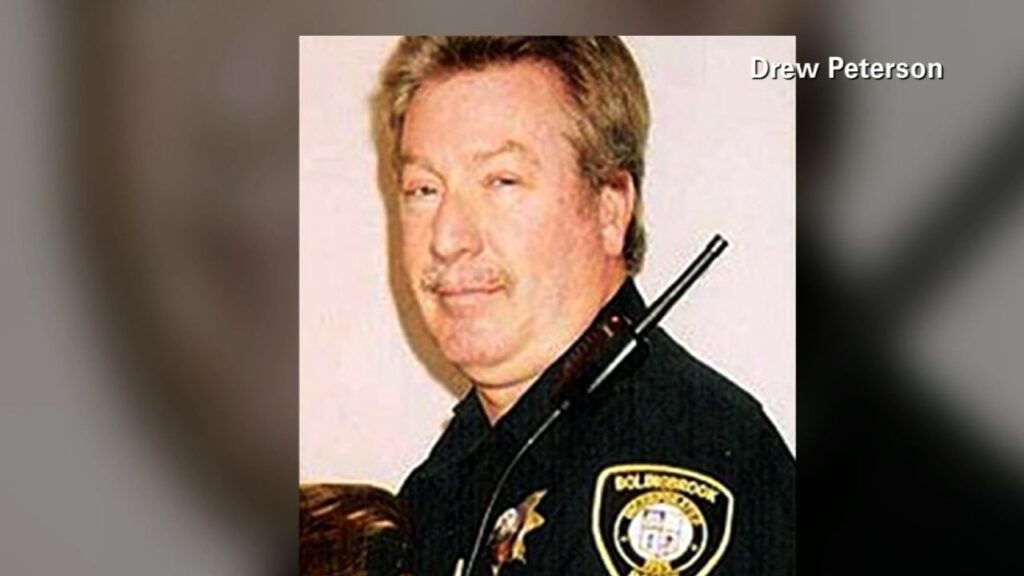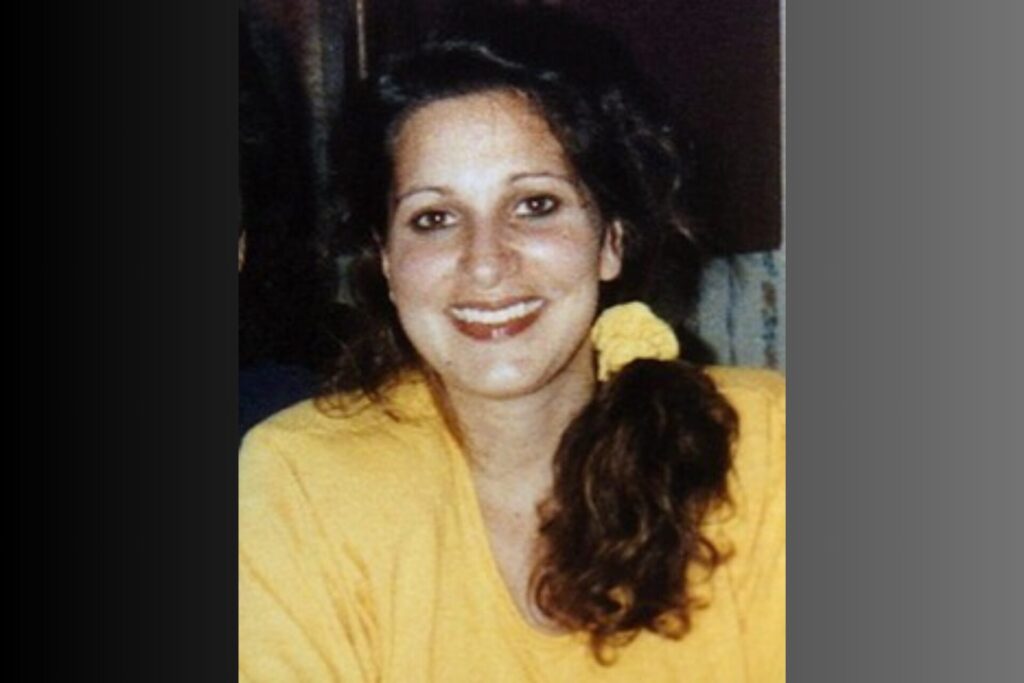Behind the badge of a trusted police officer, Drew Peterson concealed a dark secret. This chilling tale of a man who abused his position of authority to target his own wives has captivated the nation. Discover the shocking truth about the Drew Peterson killer who became known as one of America’s most notorious serial killers.
Table of Contents
Double Life, New Wife: Police Officer Drew Peterson
Drew Peterson, a seemingly all-American figure—father, husband, military veteran, and police officer—grew up in a strict household in Villa Park, Illinois. A high school cross-country runner with a reputation as a class clown and a charmer, he joined an elite military police unit in 1972, safeguarding presidents and government officials. During his service, he married his high school sweetheart, Carol Hamilton, with whom he had two sons. By 1977, at 23 years old, he joined the Bolingbrook Police Department, quickly rising to the rank of sergeant within a year.

In 1979, Drew’s exceptional work was recognized as he was named Police Officer of the Year, leading to his promotion to the metro-area narcotics squad. While his career thrived, his personal life crumbled. During his undercover assignments, he cheated on his wife, prompting Carol to realize the marriage was beyond repair and file for divorce.
Then in 1982, Drew married Vicki Connolly, who brought a daughter into their blended family with his two sons. However, his violent tendencies emerged as he threatened and intimidated her, even pointing a gun at her while suggesting he could kill her and make it look like an accident. He displayed controlling and jealous behavior, going as far as planting listening devices in their home to catch her in supposed acts of infidelity. This unstable personality, characterized by self-centeredness and narcissism, made their relationship tumultuous. On one occasion, Vicki even survived a suspicious car accident, leading some to speculate that Drew had tampered with the brakes beforehand.

Drew’s professional life mirrored his turbulent personal life. In 1985, he was terminated from the police force on charges of disobedience, failure to report a bribe promptly, and misconduct. Allegations surfaced that he had leaked information to an outlaw biker gang, potentially jeopardizing an undercover drug operation. Drew’s disregard for his duty as a police officer and his self-serving actions caught up with him, but the charges were ultimately dropped, and he was reinstated as a patrol sergeant.
While still married to Vicki, Drew met Kathleen Savio, a devoted, intelligent, and ambitious woman with a radiant smile. Strong-willed and opinionated, she was working as a bookkeeper when their paths crossed. Upon discovering Drew’s affair with Kathleen, Vicki filed for divorce and just two months after their divorce was finalized, Drew married Kathleen, his third wife—whom he had known for only six months.
The two had two sons together, but their relationship soon turned sour. Drew became verbally abusive, resorting to physical violence. He would snatch the phone away from Kathleen when she confided in her family, dismissing her concerns as delusions and hanging up. His escalating abuse culminated in a violent attack that hospitalized Kathleen, though she claimed she had merely fallen. Drew’s reign of terror on his family was intensifying, with his crimes and violence becoming increasingly frequent.

In 2001, the 47-year-old Drew embarked on yet another affair, this time with a 17-year-old hotel clerk named Stacy Cales. As their relationship deepened, the young woman believed she had found true love, drawn in by his financial security and the stable lifestyle he provided – a home, a car, and extravagant vacations.
Months later, Kathleen received an anonymous letter revealing Drew’s affair with Stacy who was pregnant with his child. The letter stated that everyone knew about the affair except for her, even though it was happening right under her own roof. Stacy would sneak into the house while Kathleen and the children slept upstairs. Drew had a hidden room in the basement, secured with a padlock, where he would secretly spend time with Stacy.
The Woman in the Bathtub: Kathleen Savio’s Murder Mystery Unraveled
Overwhelmed by the infidelity and abuse, Kathleen filed for divorce, but her desire for a fair settlement threatened to financially ruin Drew. This sparked a bitter and contentious battle as their relationship deteriorated further. By Spring of 2002, Drew had moved on with his pregnant girlfriend, Stacy. He purchased a home down the street from his estranged wife, Kathleen, to stay close to his children. However, despite their divorce, police were still called to intervene in domestic disputes between Drew and Kathleen.
Living up the street from her soon-to-be ex-husband, who had left her for a younger woman, was difficult for Kathleen. Stacy exacerbated the situation with her antagonistic behavior, often taunting Kathleen and flaunting Drew’s betrayal. One day, when Drew was returning the children to Kathleen, Stacy jumped in Kathleen’s face with her video camera. As Kathleen reacted, Stacy started yelling, “You hit me!” and Drew, abusing his authority as a police officer, put Kathleen in a headlock, restrained her on the curb, and arrested her. Although the charges were later expunged, this incident demonstrated Drew’s willingness to use his position to intimidate and control.
On October 10, 2003, Drew and Kathleen divorced without resolving the financial aspects of the settlement, solely so Drew could marry Stacy. A mere week later, Stacy indeed became his fourth wife. However, his troubles persisted as Kathleen sought a fair division of their assets, including child support and a share of Drew’s pension.
Police were summoned to Kathleen’s home on numerous occasions, responding to nearly eighteen domestic disturbances between her and Drew. Fearing for her safety and sensing escalating violence, she wrote a letter to prosecutors on November 14, 2003, pleading for protection. She expressed concerns about Drew’s manipulative nature and the possibility of him taking the children or even killing her.
In late February 2004, Drew spent the day with his children and returned them to Kathleen’s home, only to find she wasn’t there. After days of unanswered calls, he called a locksmith to open the door and then asked a married couple living next door to enter the house first, citing their contentious relationship. The neighbors made the chilling discovery of Kathleen’s lifeless body in the bathtub—their terrified screams brought Drew running, who then called the police.
Kathleen’s body showed signs of trauma, including bruises and a wound on the back of her head. The scene initially suggested a fall, but suspicions lingered. The autopsy report revealed a disturbing detail: Kathleen’s lungs were filled with water, but there was no water in the bathtub. Nevertheless, Drew maintained that he had been with his wife and children at the time of her death.
When police interviewed Stacy, Drew insisted on being present, a request the officers granted as a professional courtesy. During the interview, Drew would often touch Stacy, finishing her sentences for her. She confirmed his alibi, stating he had been with her all night, but later, she called her sister Cassandra, distraught over Kathleen’s death. Despite a clear financial motive, officers initially ruled out foul play in her death.
Gone Without a Trace: Fourth Wife Stacy Ann Cales Sudden Disappearance
For the next three years, Drew Peterson and Stacy Ann Cales appeared to live a normal suburban life, having two children together. Drew showered Stacy with gifts, including braces, a tummy tuck, and breast augmentation. However, his true nature eventually surfaced, as he became abusive, controlling, and jealous, even using a GPS device to track Stacy’s movements. Feeling trapped and fearing for her safety, Stacy resolved to leave Drew, but shortly after making this decision, she vanished without a trace.
When 22-year-old Cassandra Cales, Stacy’s sister, visited the couple’s home, her nephew answered the door and revealed that his parents had argued, prompting Stacy to leave and Drew to go after her. Cassandra then called her brother-in-law, who claimed Stacy had taken her bikini, the house deed, $25,000, and was cheating on him. She was skeptical of Drew’s story, knowing her sister wouldn’t abandon her children. On October 29th, 2007, she officially reported her 23-year-old sister missing.

When interviewed by police, Drew stated that he arrived home from a midnight shift between 5:30 AM and 6 AM. Stacy informed him she was going to run errands and never returned. He later claimed to have received a call from her saying she was leaving with another man. Eventually, he began searching for her, but without success, however, he found her car at the airport, which he retrieved and brought back home. Drew allowed officers to search the house for any signs of foul play, such as bloodstains, weapons, or a struggle. However, when asked for permission to search both his and Stacy’s vehicles, he consented to his car being searched but refused for Stacy’s car.
Trial by Media: The Peterson Case Under the Spotlight
The case quickly grabbed headlines, yet Drew appeared unfazed by her disappearance. In interviews, he asserted that she had left with another man and dismissed the need for searches. News outlets seized on the peculiar story of a police officer with four marriages, a missing wife, and the unexplained death of another. Drew became a media sensation, frequently appearing on the news to deny any involvement in Stacy’s vanishing or Kathleen’s death, infamously stating, “Why would I look for somebody who isn’t missing? She’s just gone.”
Drew, seemingly relishing the media attention, followed the cameras around with his own camera, documenting the spectacle. He believed his bizarre media appearances would paint him in a positive light, but instead, they only served to expose his narcissistic personality and deepen suspicions about his involvement in Stacy’s disappearance. His attempts to control the narrative backfired, fueling public intrigue and raising even more questions about his motives.
Digital Deception: The Texts That Sealed Stacy’s Fate
The investigation into the missing wife’s disappearance revealed that she had been in contact with an individual name Scott Rosetto. During a police interview, Scott explained that they had reconnected in October after Stacy found his phone number while cleaning. Their relationship was platonic, and she confided in him about her unhappiness and desire for a divorce from Drew. A week before her disappearance, the two had dinner together when Drew unexpectedly appeared at the restaurant, silently staring at them before telling Scott to stop seeing his wife. He became visibly agitated and demanded Scott’s identification, causing him to feel threatened and fearful.
Although Scott, a nurse, had a solid alibi for the night of Stacy’s disappearance, Drew claimed he received a call from her that evening. However, the cell phone records showed the calls from Stacy originated near Scott’s residence. Then, police discovered racy text messages from Stacy, suggesting an affair. They confronted Scott about the texts, and he admitted to flirting with Stacy but denied any physical relationship. He revealed that Stacy had been pursuing him romantically, but he had rebuffed her advances. Yet, the mystery remained: why was Stacy’s phone near Scott if he wasn’t with her?
Bound by Blood, Haunted by Regret: A Brother’s Deadly Secret
The night before Stacy vanished, Drew confided in his brother, Thomas Morphy, about Stacy’s alleged affair and his need to address the “problem.” The following day, they met at a park, where Drew handed Thomas a phone and instructed him not to answer it. Drew left, and Thomas waited, sipping his Starbucks coffee. Thirty minutes later, the phone rang, displaying Stacy’s number. Thomas let it ring several times before Drew returned, picked him up, and asked for help at his house.
Haunted by the belief that he had helped Drew dispose of Stacy’s body, Thomas spiraled into despair, turning to alcohol to numb his guilt and regret—even attempting suicide in his remorse. When police investigated Thomas’s claims, they launched a manhunt for the blue barrel, desperate to uncover the truth about Stacy’s disappearance.
To counter Thomas’s accusations, Drew appeared on a media show, attempting to discredit his brother by highlighting his emotional struggles and claiming Thomas was experiencing difficulties due to the loss of his wife and home, a drinking problem, and a suicide attempt. However, Drew’s composed demeanor during the interview did little to dispel suspicions. While police acknowledged Thomas’s history of substance abuse, they found his story to be consistent and credible.
They corroborated key details, such as the Starbucks visit, with surveillance footage showing Drew and Thomas at the coffee shop at the time Thomas claimed. This evidence, along with Thomas’s unwavering account, led police to dismiss Drew’s attempt to smear his brother’s reputation.
Subsequently, Cassandra recalled seeing a blue barrel while Stacy was still alive. She had asked Stacy about it, and Stacy had dismissed it as containing pool supplies. Cassandra hadn’t given it a second thought until now, and with her recollection of the barrel and Thomas’s account of its removal, police were able to construct a possible scenario of Stacy’s fate.
A Killer’s Motive: Unmasking the Darkness Within Drew Peterson
On the morning of October 28th, investigators believed that Drew discovered Stacy texting Scott, triggering a fit of rage that led him to strangle her. He then concealed her body in the blue barrel, sealing it shut. In an attempt to divert suspicion, he took Stacy’s phone and placed it near Scott’s home, hoping to frame him as the last person she was with. Finally, Drew disposed of her body.
On November 9th, the police declared the case a potential homicide, naming Drew as their prime suspect. They recognized his narcissistic personality and believed him capable of murder, but the lack of a body presented a significant challenge. Without a body, too many questions remained unanswered. Investigators delving into Drew’s past uncovered a disturbing pattern connecting Stacy’s disappearance to Kathleen’s death, initially ruled an accident.
In November 2007, Kathleen’s body was exhumed, and the original autopsy photos reexamined, revealing sixteen distinct injuries. The injuries, inconsistent with a simple fall in a small bathtub, led to the conclusion that Kathleen’s drowning was a homicide. A return to the crime scene confirmed the absence of any surface that could have caused the head wound found on Kathleen, further solidifying the suspicion of foul play. The lack of forced entry suggested the perpetrator was either let in or had a key, pointing directly to Drew. It became clear that Kathleen’s death was not an accident, but a violent attack.
The Bachelor with a Body Count: Drew Peterson’s Deadly Dating Game
As pressure intensified, Drew sought legal counsel, and his lawyer cautioned him against speaking to the media, fearing he might incriminate himself. Despite this advice, Drew couldn’t resist the spotlight. He even engaged with Steve Dahl—a radio personality known for impersonating him. Together, Drew and his attorney approached Steve with the idea of airing a “win a date with Drew” contest. Drew explained that his wife had left him, and he was seeking new connections through the radio. However, the public’s perception of him as a potential wife-killer had already solidified, leading many to believe this contest was a dangerous ploy to find his next victim. Due to public outcry, the radio station scrapped the idea.
Shortly afterward, Drew met Christina Raines—a woman significantly younger than him—at a nightclub in Naperville, Illinois. Their whirlwind romance raised eyebrows, as it seemed insensitive given the recent events. However, their relationship was short-lived and fraught with tension as Christina, overwhelmed by the media scrutiny and Drew’s controlling behavior, quickly moved out. She later shared her experiences in a tell-all book, shedding light on Drew’s manipulative tactics and further tarnishing his already damaged reputation.
On February 21, 2008, Kathleen’s death was officially reclassified as a homicide, with Drew emerging as the prime suspect. The investigation, now focused on a former colleague, required a strategic shift in tactics. Drew, anticipating the standard police interrogation playbook, was ready to counter their moves. However, on May 7th, 2009, authorities surprised him with an arrest, charging him with two counts of first-degree murder in Kathleen’s death. His bail was set at a staggering $20 million.
The People vs. Peterson: A Battle for Truth in the Courtroom
The case against Drew lacked concrete physical evidence. With no DNA or fingerprints linking him to the murders, the prosecution relied heavily on circumstantial evidence and hearsay testimony. Both Kathleen and Stacy had confided in numerous friends and family members about their fear of Drew and his threats to kill them. Kathleen, in particular, had expressed her belief that Drew would make her death appear accidental. This, coupled with the fact that she stood to gain a significant amount of money and property in their divorce settlement, painted a compelling, albeit circumstantial, picture of Drew’s motive and potential guilt.
The prosecution argued that Drew was so consumed by greed and a desire to protect his assets that he resorted to murdering Kathleen to avoid sharing his wealth and property with her. To illustrate Drew’s violent tendencies, they presented testimony from a witness who claimed that Kathleen had once described a terrifying incident where she saw Drew in a combat uniform, and he attacked her. Prosecutors further asserted that Drew had forcefully drowned Kathleen in the toilet, then staged the scene to resemble an accidental drowning by placing her in the bathtub without water.
Prosecutors called Neil Schori, a pastor who had counseled Stacy and Drew on marital and personal issues, conducting individual and couples sessions with them. In court, he provided hearsay testimony about a conversation with Stacy, where she urgently requested a meeting to discuss the night of Kathleen’s murder. According to Neil, she described going to bed with Drew, only to wake up later and find him missing. Her calls to him went unanswered, and he offered no explanation for his absence.
Hours later, Stacy heard Drew return, entering the laundry room clad in black. He carried a duffel bag filled with unfamiliar women’s clothing, which he promptly dumped into the washing machine. Pulling her aside, he warned Stacy that the police would be questioning her about his whereabouts that night. For hours, he coached her on what to say, instilling fear in her heart. She ultimately lied to the police to protect Drew, a decision she tearfully confessed to the pastor. Overwhelmed with dread, she begged the pastor to keep their conversation confidential, fearing that even if she escaped, Drew would track her down. The pastor, bound by his vows, agreed to keep her secret.
Subsequently, in a desperate move, Drew’s defense called divorce attorney Harry Smith to the stand, aiming to prove that Stacy had been planning to leave Drew. However, Smith’s testimony backfired spectacularly. He revealed that Stacy had contacted him to inquire about leaving the state with the children and whether she could secure a larger divorce settlement by informing the police about Drew’s involvement in Kathleen’s murder. This bombshell revelation shattered the defense’s strategy and dealt a devastating blow to Drew’s case.
The End of the Line: Drew’s Final Chapter
On September 6, 2012, after 14 hours of deliberation, 58-year-old Drew was found guilty of first-degree murder and sentenced to 38 years in prison for Kathleen’s death, making him eligible for parole at 93. While incarcerated, he harbored intense hatred towards state’s attorney Jim Glasgow—confiding in fellow inmate Antonio “The Beast” Smith that he was seeking someone to kill Glasgow. Antonio alerted authorities, sharing details of Drew’s plot—confirming Drew’s desire to have Glasgow killed.
To gather evidence, investigators equipped Antonio with a recording device, and after informing Drew about an “uncle” who could carry out the hit, Drew reacted with enthusiasm on tape. He even joked about celebrating Glasgow’s death with a drink. This The End of the Line: Peterson’s Final Chapter recorded conversation provided crucial evidence of Drew’s intent to solicit murder.
To gather evidence, investigators equipped Antonio with a recording device, and after informing Drew about an “uncle” who could carry out the hit, Drew reacted with enthusiasm on tape. He even joked about celebrating Glasgow’s death with a drink. This recorded conversation provided crucial evidence of Drew’s intent to solicit murder.
On February 9th, 2015, Drew faced trial for attempting to hire a hitman to kill the prosecutor who had secured his conviction. During the trial, fellow inmate Antonio testified that Drew had confessed to killing Stacy and disposing of her body in Lake Michigan. The jury, after a brief deliberation, found Drew guilty of conspiracy to commit murder, resulting in an additional 40-year sentence.
Despite Drew’s conviction for the murder of Kathleen Savio and his alleged confession regarding Stacy’s death, Stacy’s remains have never been found. This leaves her case officially open, a source of immense pain and unanswered questions for her family. Drew has consistently maintained his innocence and refused to disclose any information about Stacy’s fate, further deepening the mystery surrounding her disappearance. The lack of closure continues to haunt her loved ones, who are left grappling with grief and the agonizing uncertainty of not knowing that truly happened to Stacy.
Today, the children of Stacy and Drew have found a stable and loving home with Drew’s oldest son, Stephen Peterson. Despite the tragic circumstances surrounding their mother’s disappearance, the boys have adapted well to their new life, forming a strong bond with Stephen and his family. They are thriving in school, participating in extracurricular activities, and receiving the support and guidance they need to heal and grow. While the pain of their mother’s absence remains, the boys have found a sense of normalcy and security in their new home, a testament to Stephen’s unwavering commitment to their well-being.
Stacy Peterson Found? Where is Stacy Peterson Buried?
Stacy Peterson has not been officially found. However, her sister, Cassandra Cales, believes she may have discovered Stacy’s remains in a canal in Illinois. Authorities have not confirmed this claim.
Stacy’s husband, Drew Peterson, is currently serving a prison sentence for the murder of his third wife. While he remains a suspect in Stacy’s disappearance, he has not been charged in connection with her case. The investigation into Stacy Peterson’s disappearance is ongoing.

Beyond the Badge: The Chilling Legacy of Drew Peterson
The Drew Peterson case is a stark reminder of the dangers of domestic violence and the importance of vigilance and holding perpetrators accountable. Drew Peterson cop who preyed on his wives, has become a symbol of betrayal and crime. It particularly highlight cases where there is a power imbalance, such as with a police officer, and shows how abuse can escalate—in the worst cases, lead to murder. Stacy Cales disappearance was the catalyst that brought Drew Peterson’s dark criminal history into the public eye. Drew’s manipulative behavior towards his wives and his attempts to control the narrative after their deaths illustrate the lengths an abuser can go to maintain power.
Similar “Murder” Stories:
- Scott Peterson: Husband Killed Pregnant Wife to Escape Mundane Life
- Junko Furuta: A Shocking Tale of Suffering and Justice
- Brice Rhodes: Recruited Teens in Violent Triple Murder
- Why did the Menendez Brothers kill their Parents?
Books and Documentaries about Drew Peterson
Watch “Drew Peterson: An American Murder Mystery”

The disappearance of 23-year-old mother of four Stacy Peterson places her police officer husband, Drew, under intense scrutiny. As investigators delve into the case, a chilling revelation emerges: Drew’s previous wife also died under suspicious circumstances.
Watch “Drew Peterson: Untouchable”

“Drew Peterson: Untouchable” is a 2012 Lifetime movie starring Rob Lowe as Drew Peterson and Kaley Cuoco as Stacy Peterson. The movie dramatizes the events surrounding the disappearance of Stacy Peterson and the subsequent investigation into the death of Peterson’s third wife, Kathleen Savio. It portrays Peterson as a manipulative and controlling figure who uses his charm and position as a police officer to evade justice.
Read “Fatal Vows: The Tragic Wives of Sergent Drew Pearson”

Chicago-area reporter Joseph Hosey delves deep into the perplexing disappearance of Stacy Peterson, drawing upon exclusive interviews with her loved ones and even Drew Peterson himself. As the case against Peterson intensifies, one chilling question persists: What happened to Stacy?
Read “Drew Peterson Exposed — Polygraphs reveal the shocking truth about Stacy Peterson and Kathleen Savio”

For the first time, Drew Peterson’s personal account of the nights surrounding Kathleen Savio’s death and Stacy Peterson’s disappearance is revealed, alongside the shocking results of his two polygraph tests. This exposé dissects the police investigations, motives, and alternative theories, shedding new light on a case riddled with conflicting accounts, false leads, and rampant rumors. Over 140 photographs and documents, many never before seen, offer an intimate look into this sensational story, painting a frank and controversial portrait of Drew Peterson that is sure to ignite further debate.
Conclusion
The case of Drew Peterson underscores a chilling misuse of authority, where Drew Peterson cop exploited his position for personal gain. The harrowing experiences of Drew Peterson’s spouses highlight the vulnerability faced when trust is manipulated. This story serves as a stark reminder of the potential dangers inherent in such abuses of power.
FAQs
Where are Drew Peterson Kids now?
Drew Peterson’s children have largely stayed out of the public eye. His oldest son, Stephen Peterson, lost his job as a police officer after his father’s arrest. The whereabouts of his other children are mostly private, with some living with relatives and trying to lead normal lives away from the spotlight.
Did all of Drew Peterson’s spouses have children with him?
No, not all of Drew Peterson’s spouses had children with him. Drew Peterson had children with his first wife, Carol Brown; his third wife, Kathleen Savio; and his fourth wife, Stacy Ann Cales. His second wife, Victoria Connolly, did not have any children with him.
Are Drew Peterson and Scott Peterson Related?
No, Drew Peterson and Scott Peterson are not related. They are two different individuals known for high-profile criminal cases involving the murder of their spouses.